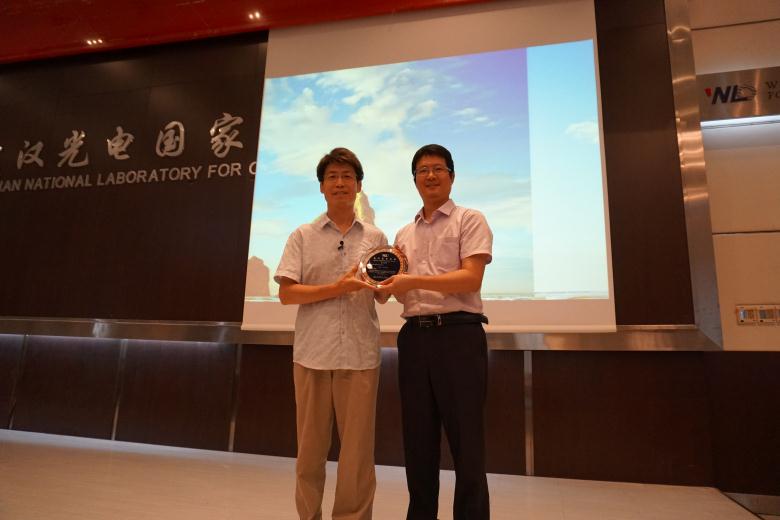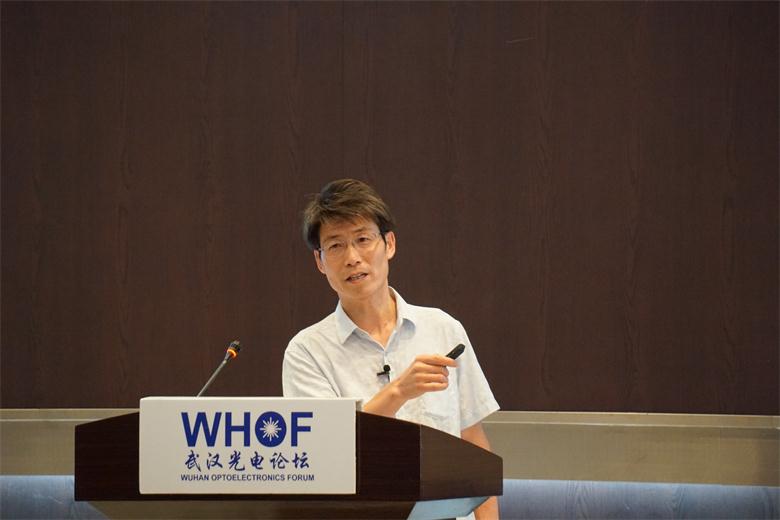WUHAN, China (July 19, 2017) - Wuhan Optoelectronics Forum No. 130 was successfully held in Auditorium A301 at Wuhan National Laboratory for Optoelectronics (WNLO) in the morning of July 19. Prof. L.Jay Guo from University of Michigan delivered an exciting talk entitled Ultrasound Detection and Imaging Using Microring Resonators and Laser Generated Focused Ultrasound. Dr. Lei Shi, from Optoelectronic Devices and Integration Division of WNLO chaired the forum. Dr. Jun Zhou, Deputy Director of WNLO, awarded Prof. L.Jay Guo the forum medal.
Optical detection of ultrasound is an emerging technique based on the interaction of strain field and optical field, modulating the optical properties of the resonance cavity for sensitive detection. Such a detection scheme can have several unique advantages, such as broadband response and size-independent sensitivity, compared with conventional piezoelectric transducers. Detector’s high sensitivity is essential for deep penetration depth, especially for high-resolution imaging because of the strong attenuation of high-frequency ultrasound. Besides, small element size has the advantage of realizing wide acceptance angle of ultrasound detection. I will describe highly sensitive and broad band detection of ultrasound by polymer photonic microring resonators, and demonstrate its application for high resolution photoacoustic tomography and photoacoustic microscopy. Similar principle can be applied to THz detection, where the microring can “listen to” the sound wave generated by the nano-material absorbing the THz energy. I will also present thin-film optical transmitters to generate and focus the ultrasound, targeting high-amplitude focused ultrasound for imaging and therapeutic applications. The optoacoustic sources are made of carbon-nanotubes (CNTs) and elastomeric polymers. As the nano-composite works as excellent optical absorbers and efficient heat converters, output pressure with strong amplitudes can be generated and has a corresponding frequency spectrum showing high-frequency characteristics. This approach could provide a versatile tool for cell engineering in terms of harvesting and patterning, and more importantly, non-thermal disruption to facilitate drug delivery and gene therapy for targeted cells. I will discuss recent experiment showing deterministic microbubble generation by highly focused high amplitude ultrasound using the photoacoustic lens.
L. Jay Guo is currently a Full Professor at the Department of Electrical Engineering and Computer Science, University of Michigan. L. Jay Guo started his academic career at the University of Michigan in 1999, and has been a full professor of Electrical Engineering and Computer Science since 2011, and affiliated with Applied Physics, Mechanical Engineering, Macromolecular Science and Engineering. He has more than 200 refereed journal publications with over 25,000 citations, and close to 20 US patents. Many published work from his lab have been featured by numerous media. He was the recipient of the Research Excellence Award from the College of Engineering at UM and Outstanding Achievement Award from the EECS department. His group’s researches include polymer-based photonic devices and sensor applications, organic and hybrid photovoltaics, plasmonic nanophotonics, nanoimprint-based and roll to roll nanomanufacturing technologies.

